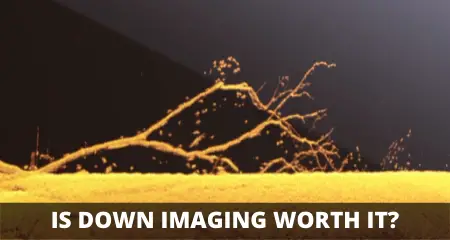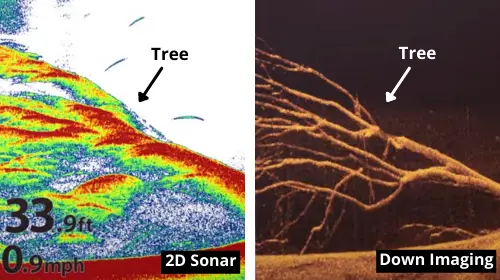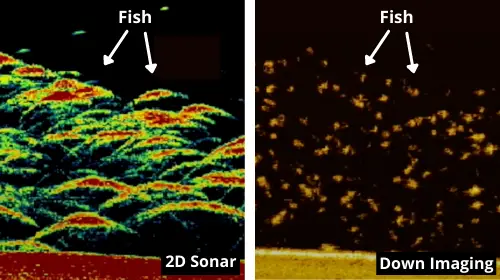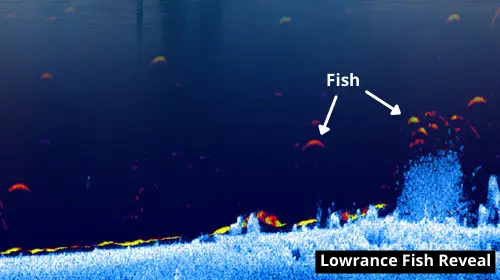What Is A Down Imaging Fish Finder (And Do You Really Need It)?
UPDATED 17 MAY 2023
by Robert Ceran
Are you thinking about getting a fish finder with down imaging functionality?
In that case you’re probably wondering what down imaging sonar is capable of, and if it’s really worth it for you.
In this article we’ll explain the key abilities of down imaging sonar, and will walk you through its main strengths and weaknesses.

We’ll also compare and contrast down imaging with 2D sonar, to help you get a better sense of what it can do for you, and decide if it’s worth getting down imaging for your purposes.
Is down imaging worth it?
Yes, down imaging is absolutely worth it if you want to fish vertically underneath your boat, as it reveals structure in great detail straight below your boat.
This enables you to identify and target specific structures with your presentation, and also allows you to see fish in the water column underneath you.
What is down imaging on a fish finder?
Down imaging is a fish finder technology that uses high frequency sonar focused in a narrow cone straight underneath your boat to generate images with very high resolution. This allows you to see everything directly under your boat in great detail.
Down imaging is an improved version of traditional 2D sonar that is optimized for greater object separation with higher frequency sonar waves (by using CHIRP in the 455 and 800 kHz range), while focusing on a very narrow cross section of water.
Down imaging vs sonar – what’s the difference?
The main difference between down imaging and sonar is that down imaging generates very high resolution images of structure, but doesn’t reveal fish very effectively, while 2D sonar generates low resolution images of structure, but reveals fish more effectively.
To see an example of the difference between down imaging and sonar when it comes to visualizing a sunken tree, check out the photo below, which compares the same tree scanned with 2D sonar (on the left) and with down imaging (on the right):

This difference in resolution is due to the fact that down imaging uses high frequency CHIRP in the 455 and 800 kHz range to achieve greater object separation, and is focused on a very narrow cross section of water.
2D sonar, on the other hand, uses lower sonar frequencies (usually in the 83 and 200 kHz range), and covers a broader area with a wider sonar cone.
And while 2D sonar is not as good at revealing structure with great detail, it tends to be better for seeing fish, which show up as broad arches on 2D sonar.
To see an example of the difference between the two types of sonar when it comes to viewing fish, check out the photo below, which compares the same school of fish scanned with 2D sonar (on the left) and with down imaging (on the right).

As you can see in the image above, fish show up as relatively wide arches on 2D sonar, while they look like small dots on down imaging.
Because of this difference, it can sometimes be hard to spot fish on down imaging, especially if the fish are small, or if they are moving through the sonar cone quickly.
Down imaging vs CHIRP
While CHIRP improves the resolution of 2D sonar, it’s still nowhere close to down imaging when it comes to viewing underwater structure with high resolution.
However, in terms of being able to reveal fish, CHIRP sonar is better than down imaging, as fish show up as distinctive arches with CHIRP 2D sonar.
Can you combine down imaging with 2D sonar?
Yes, you can combine down imaging with 2D sonar, and this is one of the most effective ways to harness the strengths of both types of sonar in parallel.
Down imaging is great for generating highly detailed structure scans, while 2D sonar is better at identifying fish in the water around the structure you’re looking at.
What is Fish Reveal on Lowrance?
Lowrance FishReveal uses an algorithm to overlay the fish arches generated with 2D sonar on top of down scan images, and thus combines the strengths of both sonar technologies into one single image (for an example of this, check out the photo below).

Lowrance fish reveal is especially useful for beginners, as it allows you to get detailed images of structure and fish on the same screen straight out of the box.
More advanced anglers, however, usually prefer to view down imaging and 2D sonar separately, in order to get the maximum amount of information from each.
Can you see fish with down imaging?
Yes, you can see fish with down imaging, which usually show up as small bright spots. This is very different from the fish arches you get with 2D sonar, and tends to make it harder to identify fish unequivocally on down imaging.
To get a better sense of what fish look like on down imaging, check out the photo above comparing fish on 2D sonar and down imaging side by side.
Can you see your lure on down imaging?
Yes, you can see your lure on down imaging, but only if you are fishing vertically, and if your lure is inside the sonar cone of the transducer.
Since the sonar cone of a down imaging transducer is a lot more narrow than that of a 2D sonar transducer, it’s not quite as easy to keep you lure inside the sonar cone.
What this means in practice is that you need to lower your lure or jig into the water as close as possible to the down imaging transducer.
For example, if you’re using a transom mounted transducer placement, you’ll need to fish off the back end of your boat.
Does down imaging work sitting still?
While down imaging does work while sitting still, this isn’t optimal for getting high quality images, since a down imaging transducer (like most kinds of sonars) requires movement to generate an accurate sonar graph.
In other words, when your boat is moving, the structure that you pass over is revealed in the historic sonar graph generated by your fish finder after you have passed over it.
But when your boat is sitting still, the sonar cone will continuously scan the same spot over and over again, and any structure that’s underneath you will show up as a straight continuous line on your sonar graph, which is not very informative.
Can you use down imaging for ice fishing?
While you can use down imaging for ice fishing, this will give you very little information compared to an ice fishing fish finder or flasher, which are designed specifically for this purpose.
The reason for this is that a down imaging transducer needs to move over the bottom in order to generate an accurate sonar graph of the structure that it passes over.
One way that you can try to mimic this when ice fishing is by moving your transducer back and forth inside an ice hole in order to get a good reading.
That way you may be able to get some useful information about the bottom consistency and vegetation underneath your ice hole.
Does down imaging work on a trolling motor?
Yes, down imaging transducers are well suited for mounting on a trolling motor, but you need to mount them in an appropriate position where the sonar beam of the transducer can scan downwards without being blocked.
The best way to achieve this is by mounting the down imaging transducer at the bottom of the motor compartment.
Several trolling motors, including the Lowrance Ghost and the Garmin Force come with built-in down imaging transducers that are mounted on the lower edge of the motor compartment.
Which fish finder has the best down imaging?
The fish finders with the best down imaging include the following lineups:
- Humminbird Helix, Solix and Apex units with Mega DI+ imaging
- Lowrance Elite FS and HDS Live units
- Garmin Echomap and GPSmap units with UHD ClearVu
Humminbird Mega DI+ imaging generates some of the finest down imaging results with incredible resolution and crisp detail.
This is due to the fact that Mega imaging uses high frequency sonar in the 1.2 megahertz range, yielding even higher target separation than 455 and 800 kHz.
On the other hand Garmin UHD ClearVu comes with almost comparable levels of clarity and resolution, and Lowrance units come with the advantage of having FishReveal technology, which combines the best of down imaging with 2D sonar overlay in the same image.
In other words, any units from the fish finder lineups listed above are likely to give you very high quality down imaging, and you’ll be more than happy with the results.
